Evaluating Business Location Strategy in New Zealand: A Report
VerifiedAdded on 2022/09/18
|8
|2077
|34
Report
AI Summary
This report evaluates the optimal location strategy for a childcare business in New Zealand, considering Auckland and Wellington. It introduces a childcare service, 'MAMA BABY CARE CENTER,' and analyzes factors like labor costs, customer density, market demand, and location attractiveness. The report highlights the relevance of these factors in decision-making and identifies market demand as the most critical criterion. It also discusses the implications of slope coefficients for operations management and suggests prioritizing payroll expenditure. The analysis includes references to relevant academic literature and provides a comprehensive overview of the business location decision-making process. The report emphasizes the importance of location accessibility and the needs of working mothers in the target market. Furthermore, it differentiates between the characteristics of Auckland and Wellington to support its recommendations.
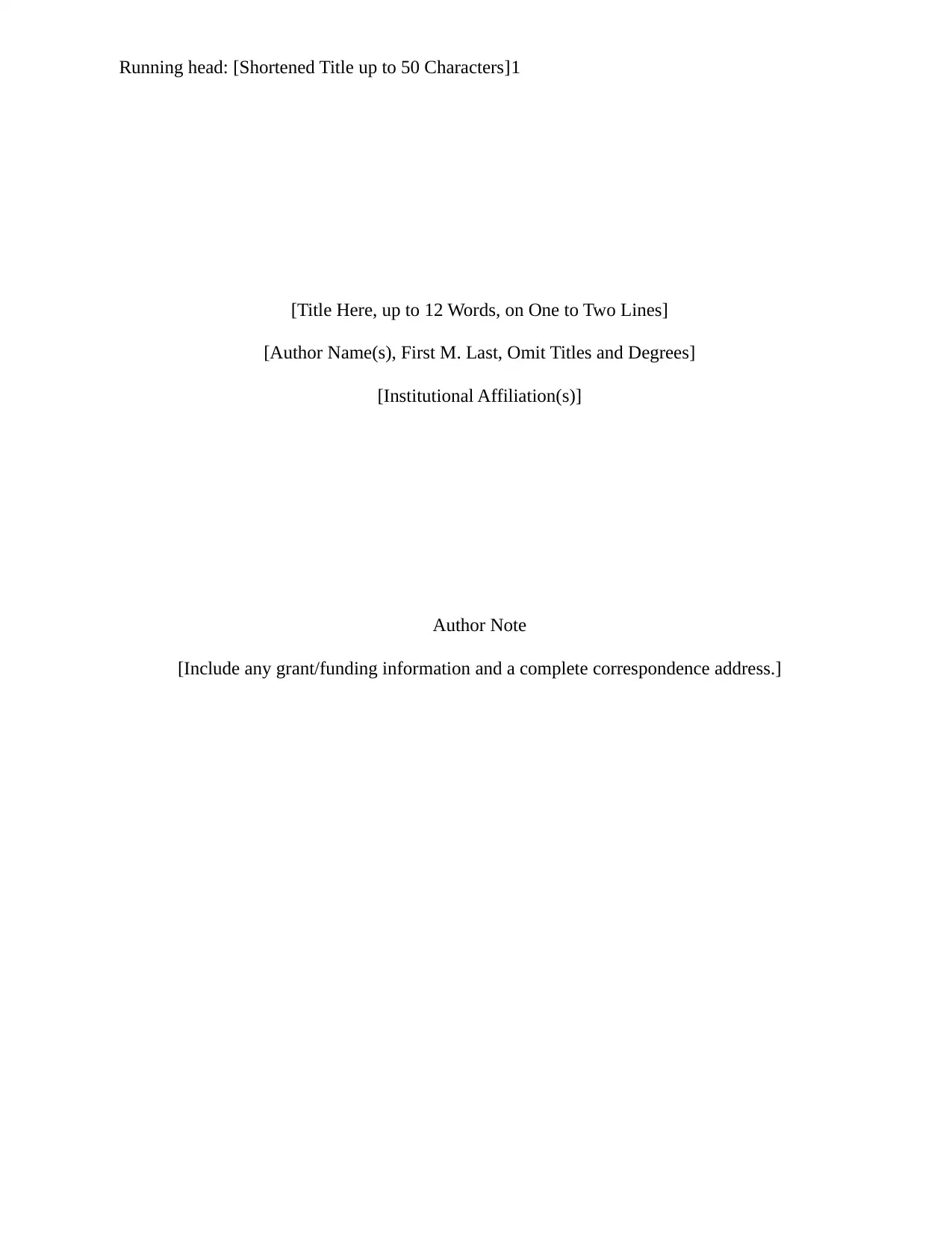
Running head: [Shortened Title up to 50 Characters]1
[Title Here, up to 12 Words, on One to Two Lines]
[Author Name(s), First M. Last, Omit Titles and Degrees]
[Institutional Affiliation(s)]
Author Note
[Include any grant/funding information and a complete correspondence address.]
[Title Here, up to 12 Words, on One to Two Lines]
[Author Name(s), First M. Last, Omit Titles and Degrees]
[Institutional Affiliation(s)]
Author Note
[Include any grant/funding information and a complete correspondence address.]
Paraphrase This Document
Need a fresh take? Get an instant paraphrase of this document with our AI Paraphraser
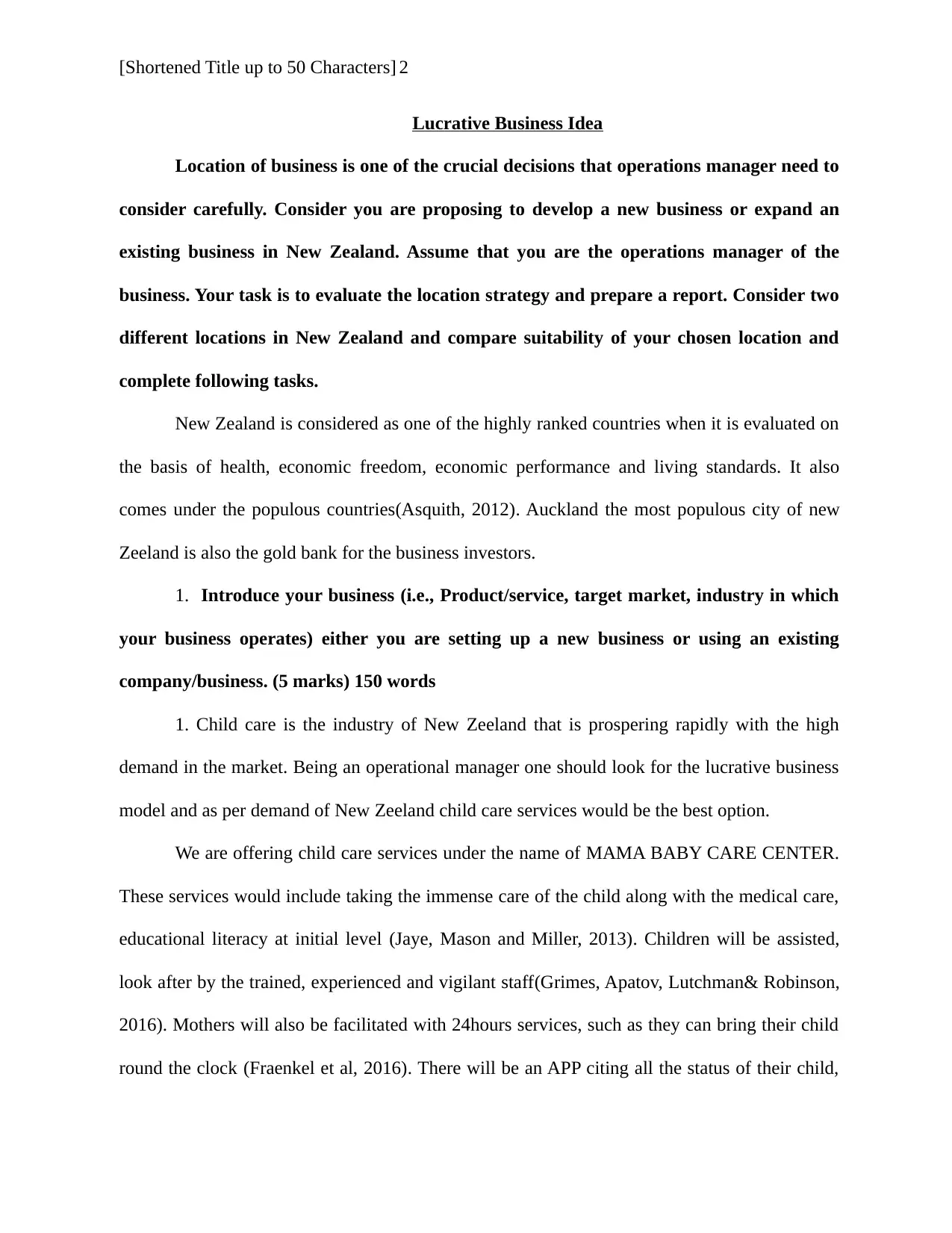
[Shortened Title up to 50 Characters] 2
Lucrative Business Idea
Location of business is one of the crucial decisions that operations manager need to
consider carefully. Consider you are proposing to develop a new business or expand an
existing business in New Zealand. Assume that you are the operations manager of the
business. Your task is to evaluate the location strategy and prepare a report. Consider two
different locations in New Zealand and compare suitability of your chosen location and
complete following tasks.
New Zealand is considered as one of the highly ranked countries when it is evaluated on
the basis of health, economic freedom, economic performance and living standards. It also
comes under the populous countries(Asquith, 2012). Auckland the most populous city of new
Zeeland is also the gold bank for the business investors.
1. Introduce your business (i.e., Product/service, target market, industry in which
your business operates) either you are setting up a new business or using an existing
company/business. (5 marks) 150 words
1. Child care is the industry of New Zeeland that is prospering rapidly with the high
demand in the market. Being an operational manager one should look for the lucrative business
model and as per demand of New Zeeland child care services would be the best option.
We are offering child care services under the name of MAMA BABY CARE CENTER.
These services would include taking the immense care of the child along with the medical care,
educational literacy at initial level (Jaye, Mason and Miller, 2013). Children will be assisted,
look after by the trained, experienced and vigilant staff(Grimes, Apatov, Lutchman& Robinson,
2016). Mothers will also be facilitated with 24hours services, such as they can bring their child
round the clock (Fraenkel et al, 2016). There will be an APP citing all the status of their child,
Lucrative Business Idea
Location of business is one of the crucial decisions that operations manager need to
consider carefully. Consider you are proposing to develop a new business or expand an
existing business in New Zealand. Assume that you are the operations manager of the
business. Your task is to evaluate the location strategy and prepare a report. Consider two
different locations in New Zealand and compare suitability of your chosen location and
complete following tasks.
New Zealand is considered as one of the highly ranked countries when it is evaluated on
the basis of health, economic freedom, economic performance and living standards. It also
comes under the populous countries(Asquith, 2012). Auckland the most populous city of new
Zeeland is also the gold bank for the business investors.
1. Introduce your business (i.e., Product/service, target market, industry in which
your business operates) either you are setting up a new business or using an existing
company/business. (5 marks) 150 words
1. Child care is the industry of New Zeeland that is prospering rapidly with the high
demand in the market. Being an operational manager one should look for the lucrative business
model and as per demand of New Zeeland child care services would be the best option.
We are offering child care services under the name of MAMA BABY CARE CENTER.
These services would include taking the immense care of the child along with the medical care,
educational literacy at initial level (Jaye, Mason and Miller, 2013). Children will be assisted,
look after by the trained, experienced and vigilant staff(Grimes, Apatov, Lutchman& Robinson,
2016). Mothers will also be facilitated with 24hours services, such as they can bring their child
round the clock (Fraenkel et al, 2016). There will be an APP citing all the status of their child,
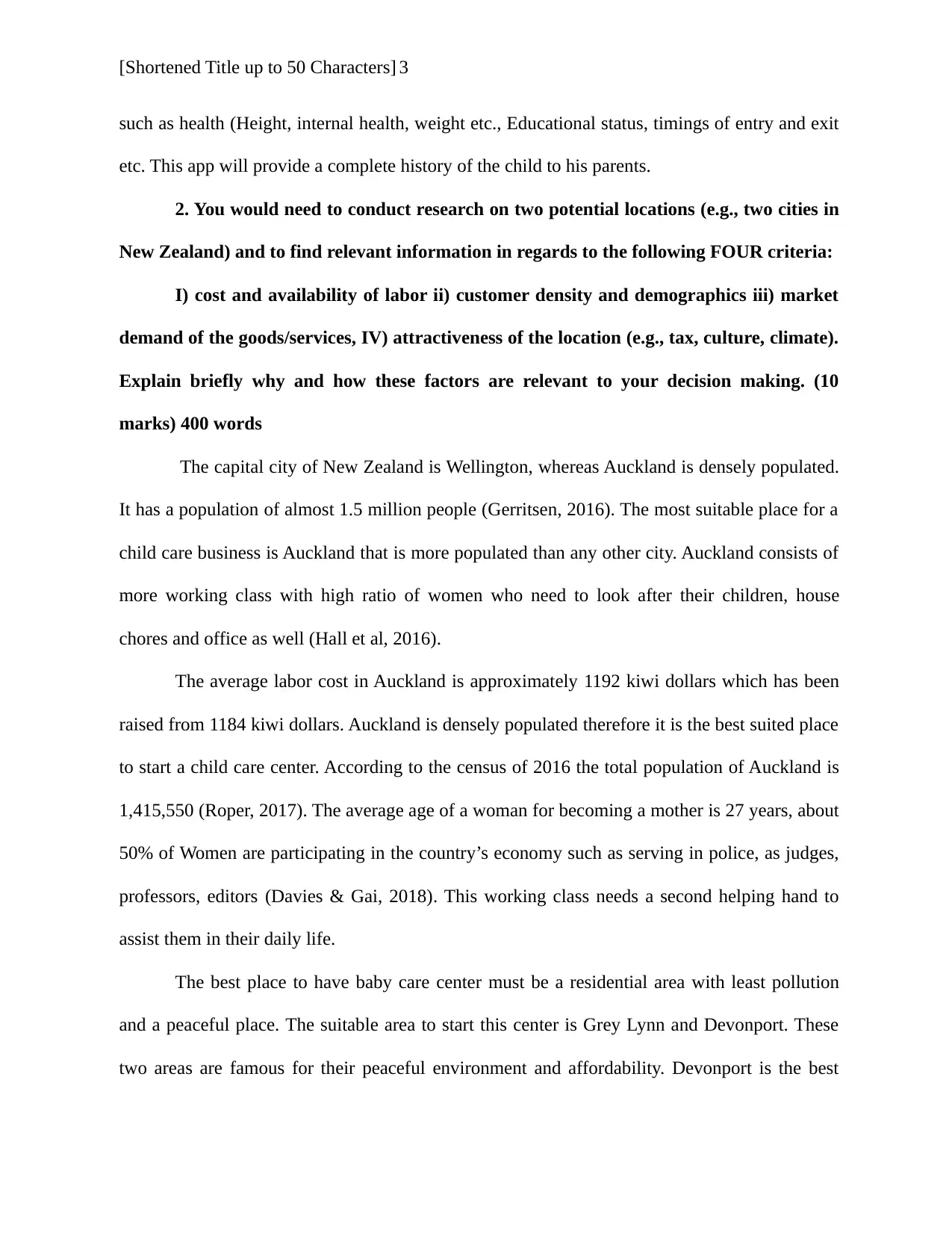
[Shortened Title up to 50 Characters] 3
such as health (Height, internal health, weight etc., Educational status, timings of entry and exit
etc. This app will provide a complete history of the child to his parents.
2. You would need to conduct research on two potential locations (e.g., two cities in
New Zealand) and to find relevant information in regards to the following FOUR criteria:
I) cost and availability of labor ii) customer density and demographics iii) market
demand of the goods/services, IV) attractiveness of the location (e.g., tax, culture, climate).
Explain briefly why and how these factors are relevant to your decision making. (10
marks) 400 words
The capital city of New Zealand is Wellington, whereas Auckland is densely populated.
It has a population of almost 1.5 million people (Gerritsen, 2016). The most suitable place for a
child care business is Auckland that is more populated than any other city. Auckland consists of
more working class with high ratio of women who need to look after their children, house
chores and office as well (Hall et al, 2016).
The average labor cost in Auckland is approximately 1192 kiwi dollars which has been
raised from 1184 kiwi dollars. Auckland is densely populated therefore it is the best suited place
to start a child care center. According to the census of 2016 the total population of Auckland is
1,415,550 (Roper, 2017). The average age of a woman for becoming a mother is 27 years, about
50% of Women are participating in the country’s economy such as serving in police, as judges,
professors, editors (Davies & Gai, 2018). This working class needs a second helping hand to
assist them in their daily life.
The best place to have baby care center must be a residential area with least pollution
and a peaceful place. The suitable area to start this center is Grey Lynn and Devonport. These
two areas are famous for their peaceful environment and affordability. Devonport is the best
such as health (Height, internal health, weight etc., Educational status, timings of entry and exit
etc. This app will provide a complete history of the child to his parents.
2. You would need to conduct research on two potential locations (e.g., two cities in
New Zealand) and to find relevant information in regards to the following FOUR criteria:
I) cost and availability of labor ii) customer density and demographics iii) market
demand of the goods/services, IV) attractiveness of the location (e.g., tax, culture, climate).
Explain briefly why and how these factors are relevant to your decision making. (10
marks) 400 words
The capital city of New Zealand is Wellington, whereas Auckland is densely populated.
It has a population of almost 1.5 million people (Gerritsen, 2016). The most suitable place for a
child care business is Auckland that is more populated than any other city. Auckland consists of
more working class with high ratio of women who need to look after their children, house
chores and office as well (Hall et al, 2016).
The average labor cost in Auckland is approximately 1192 kiwi dollars which has been
raised from 1184 kiwi dollars. Auckland is densely populated therefore it is the best suited place
to start a child care center. According to the census of 2016 the total population of Auckland is
1,415,550 (Roper, 2017). The average age of a woman for becoming a mother is 27 years, about
50% of Women are participating in the country’s economy such as serving in police, as judges,
professors, editors (Davies & Gai, 2018). This working class needs a second helping hand to
assist them in their daily life.
The best place to have baby care center must be a residential area with least pollution
and a peaceful place. The suitable area to start this center is Grey Lynn and Devonport. These
two areas are famous for their peaceful environment and affordability. Devonport is the best
⊘ This is a preview!⊘
Do you want full access?
Subscribe today to unlock all pages.

Trusted by 1+ million students worldwide
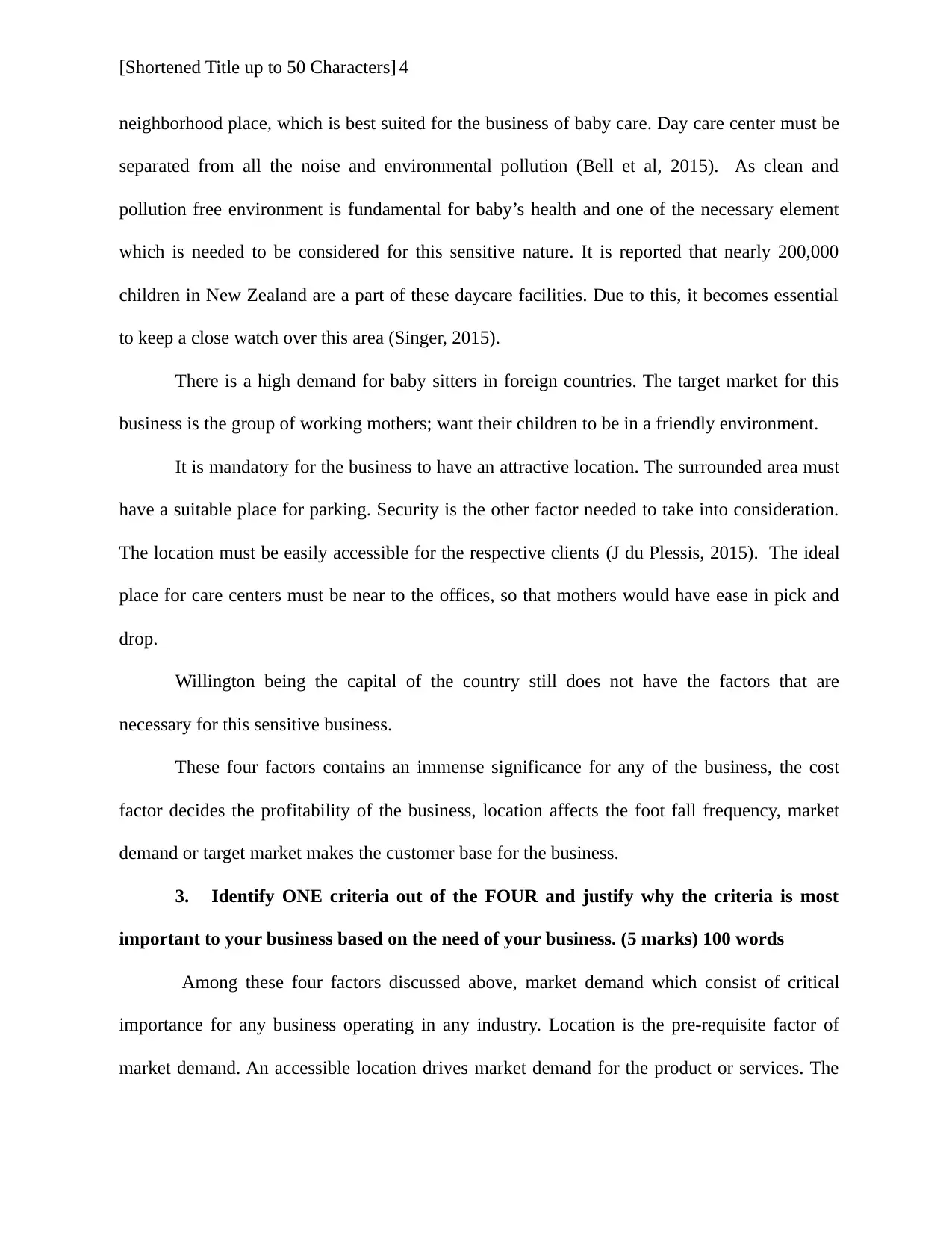
[Shortened Title up to 50 Characters] 4
neighborhood place, which is best suited for the business of baby care. Day care center must be
separated from all the noise and environmental pollution (Bell et al, 2015). As clean and
pollution free environment is fundamental for baby’s health and one of the necessary element
which is needed to be considered for this sensitive nature. It is reported that nearly 200,000
children in New Zealand are a part of these daycare facilities. Due to this, it becomes essential
to keep a close watch over this area (Singer, 2015).
There is a high demand for baby sitters in foreign countries. The target market for this
business is the group of working mothers; want their children to be in a friendly environment.
It is mandatory for the business to have an attractive location. The surrounded area must
have a suitable place for parking. Security is the other factor needed to take into consideration.
The location must be easily accessible for the respective clients (J du Plessis, 2015). The ideal
place for care centers must be near to the offices, so that mothers would have ease in pick and
drop.
Willington being the capital of the country still does not have the factors that are
necessary for this sensitive business.
These four factors contains an immense significance for any of the business, the cost
factor decides the profitability of the business, location affects the foot fall frequency, market
demand or target market makes the customer base for the business.
3. Identify ONE criteria out of the FOUR and justify why the criteria is most
important to your business based on the need of your business. (5 marks) 100 words
Among these four factors discussed above, market demand which consist of critical
importance for any business operating in any industry. Location is the pre-requisite factor of
market demand. An accessible location drives market demand for the product or services. The
neighborhood place, which is best suited for the business of baby care. Day care center must be
separated from all the noise and environmental pollution (Bell et al, 2015). As clean and
pollution free environment is fundamental for baby’s health and one of the necessary element
which is needed to be considered for this sensitive nature. It is reported that nearly 200,000
children in New Zealand are a part of these daycare facilities. Due to this, it becomes essential
to keep a close watch over this area (Singer, 2015).
There is a high demand for baby sitters in foreign countries. The target market for this
business is the group of working mothers; want their children to be in a friendly environment.
It is mandatory for the business to have an attractive location. The surrounded area must
have a suitable place for parking. Security is the other factor needed to take into consideration.
The location must be easily accessible for the respective clients (J du Plessis, 2015). The ideal
place for care centers must be near to the offices, so that mothers would have ease in pick and
drop.
Willington being the capital of the country still does not have the factors that are
necessary for this sensitive business.
These four factors contains an immense significance for any of the business, the cost
factor decides the profitability of the business, location affects the foot fall frequency, market
demand or target market makes the customer base for the business.
3. Identify ONE criteria out of the FOUR and justify why the criteria is most
important to your business based on the need of your business. (5 marks) 100 words
Among these four factors discussed above, market demand which consist of critical
importance for any business operating in any industry. Location is the pre-requisite factor of
market demand. An accessible location drives market demand for the product or services. The
Paraphrase This Document
Need a fresh take? Get an instant paraphrase of this document with our AI Paraphraser
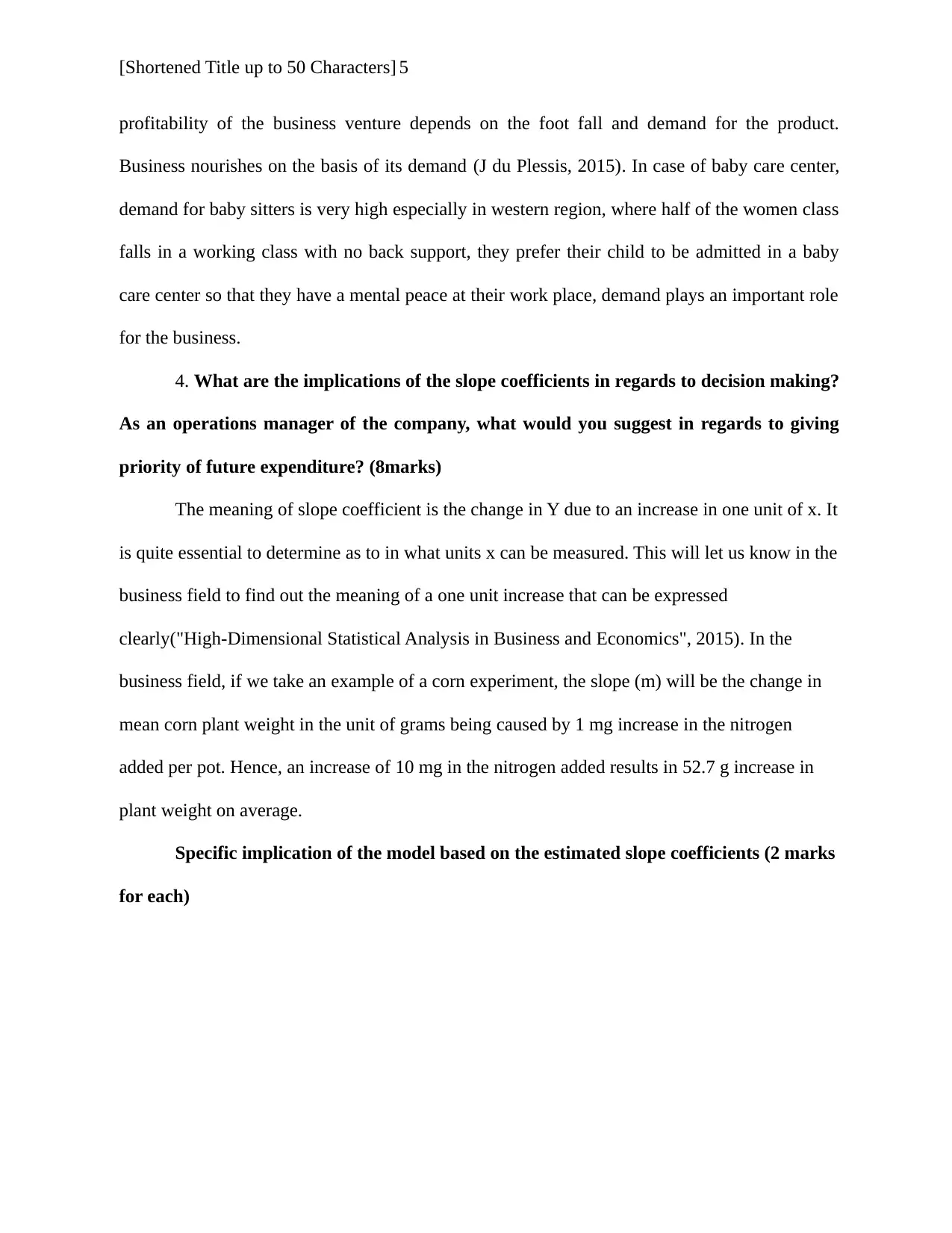
[Shortened Title up to 50 Characters] 5
profitability of the business venture depends on the foot fall and demand for the product.
Business nourishes on the basis of its demand (J du Plessis, 2015). In case of baby care center,
demand for baby sitters is very high especially in western region, where half of the women class
falls in a working class with no back support, they prefer their child to be admitted in a baby
care center so that they have a mental peace at their work place, demand plays an important role
for the business.
4. What are the implications of the slope coefficients in regards to decision making?
As an operations manager of the company, what would you suggest in regards to giving
priority of future expenditure? (8marks)
The meaning of slope coefficient is the change in Y due to an increase in one unit of x. It
is quite essential to determine as to in what units x can be measured. This will let us know in the
business field to find out the meaning of a one unit increase that can be expressed
clearly("High-Dimensional Statistical Analysis in Business and Economics", 2015). In the
business field, if we take an example of a corn experiment, the slope (m) will be the change in
mean corn plant weight in the unit of grams being caused by 1 mg increase in the nitrogen
added per pot. Hence, an increase of 10 mg in the nitrogen added results in 52.7 g increase in
plant weight on average.
Specific implication of the model based on the estimated slope coefficients (2 marks
for each)
profitability of the business venture depends on the foot fall and demand for the product.
Business nourishes on the basis of its demand (J du Plessis, 2015). In case of baby care center,
demand for baby sitters is very high especially in western region, where half of the women class
falls in a working class with no back support, they prefer their child to be admitted in a baby
care center so that they have a mental peace at their work place, demand plays an important role
for the business.
4. What are the implications of the slope coefficients in regards to decision making?
As an operations manager of the company, what would you suggest in regards to giving
priority of future expenditure? (8marks)
The meaning of slope coefficient is the change in Y due to an increase in one unit of x. It
is quite essential to determine as to in what units x can be measured. This will let us know in the
business field to find out the meaning of a one unit increase that can be expressed
clearly("High-Dimensional Statistical Analysis in Business and Economics", 2015). In the
business field, if we take an example of a corn experiment, the slope (m) will be the change in
mean corn plant weight in the unit of grams being caused by 1 mg increase in the nitrogen
added per pot. Hence, an increase of 10 mg in the nitrogen added results in 52.7 g increase in
plant weight on average.
Specific implication of the model based on the estimated slope coefficients (2 marks
for each)
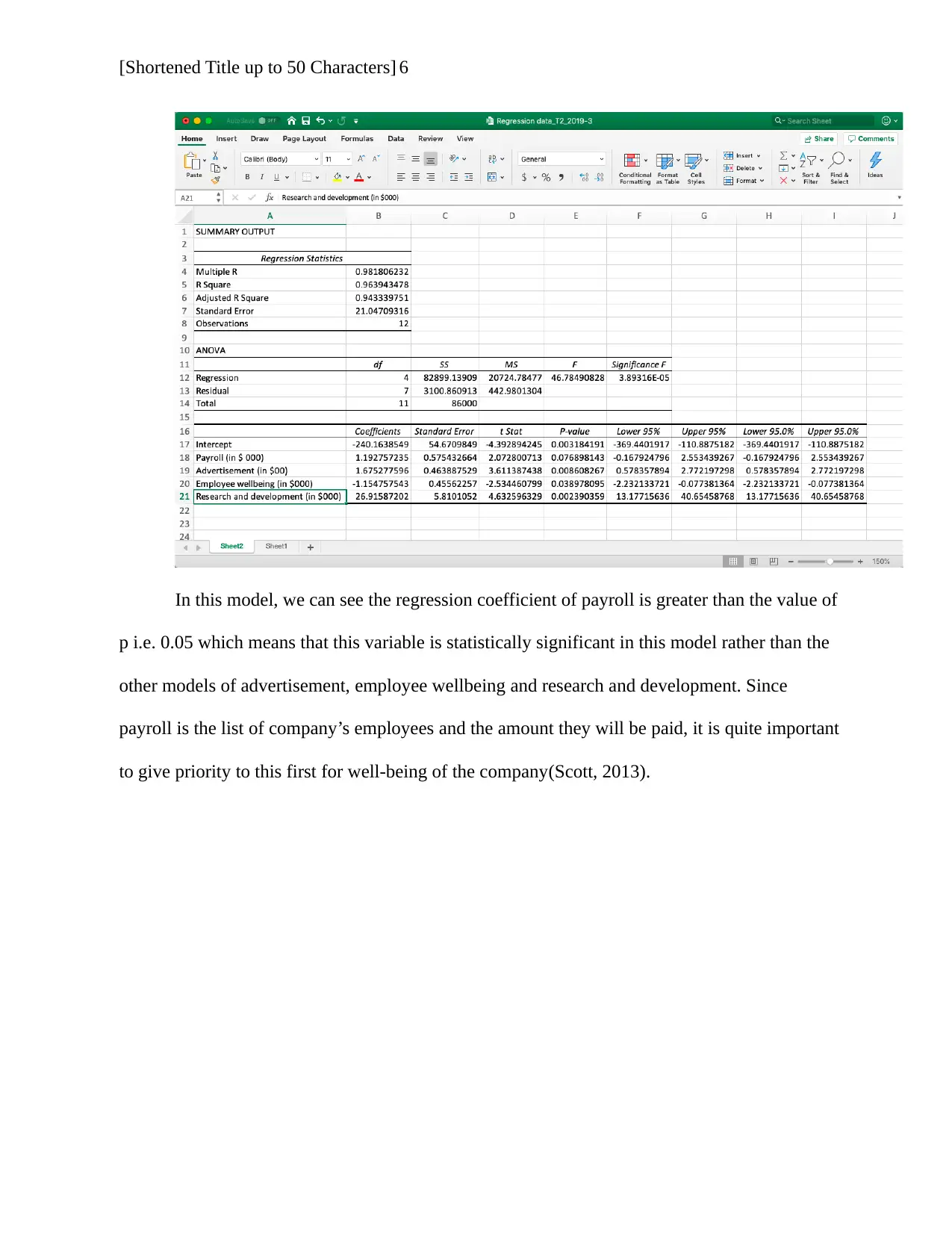
[Shortened Title up to 50 Characters] 6
In this model, we can see the regression coefficient of payroll is greater than the value of
p i.e. 0.05 which means that this variable is statistically significant in this model rather than the
other models of advertisement, employee wellbeing and research and development. Since
payroll is the list of company’s employees and the amount they will be paid, it is quite important
to give priority to this first for well-being of the company(Scott, 2013).
In this model, we can see the regression coefficient of payroll is greater than the value of
p i.e. 0.05 which means that this variable is statistically significant in this model rather than the
other models of advertisement, employee wellbeing and research and development. Since
payroll is the list of company’s employees and the amount they will be paid, it is quite important
to give priority to this first for well-being of the company(Scott, 2013).
⊘ This is a preview!⊘
Do you want full access?
Subscribe today to unlock all pages.

Trusted by 1+ million students worldwide
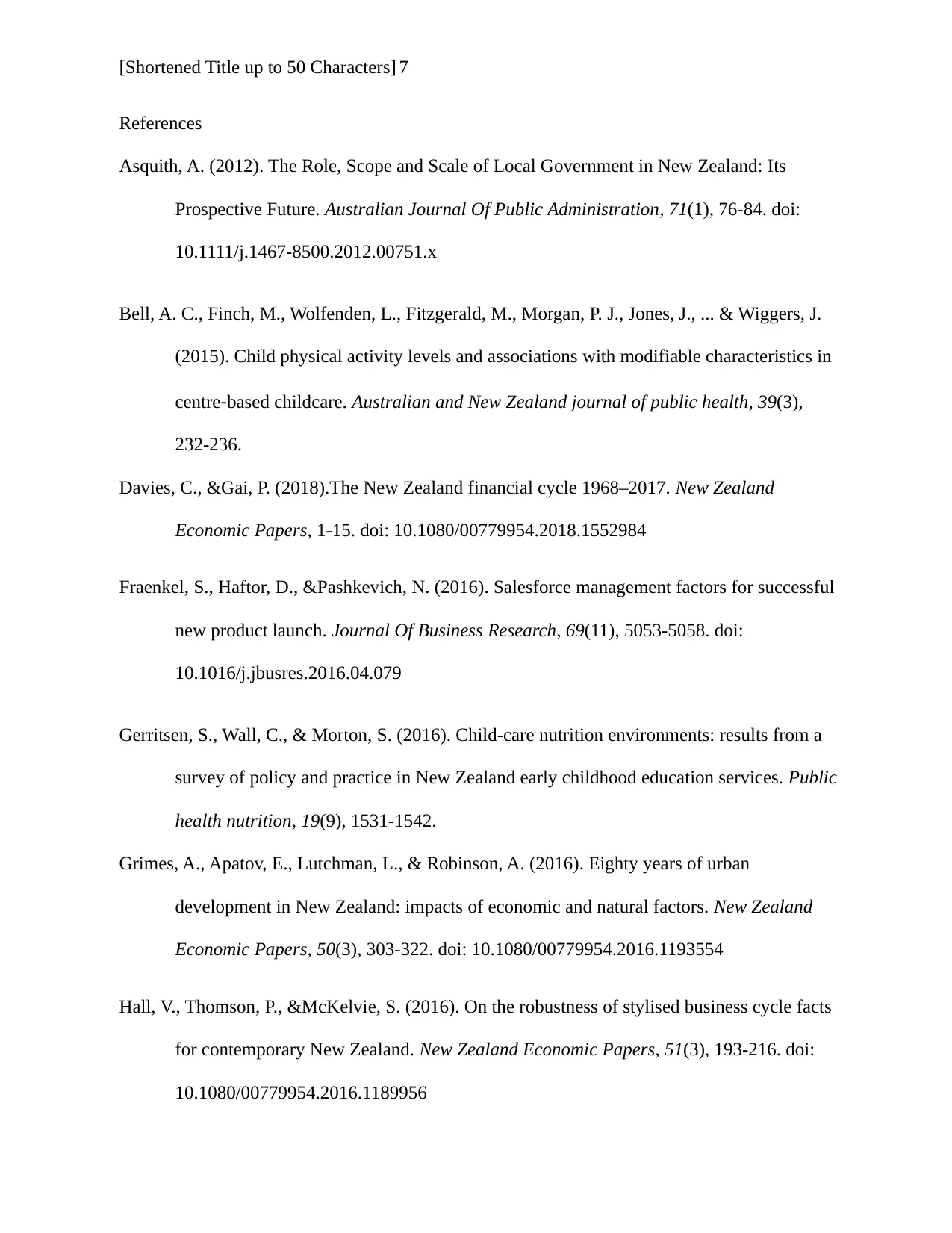
[Shortened Title up to 50 Characters] 7
References
Asquith, A. (2012). The Role, Scope and Scale of Local Government in New Zealand: Its
Prospective Future. Australian Journal Of Public Administration, 71(1), 76-84. doi:
10.1111/j.1467-8500.2012.00751.x
Bell, A. C., Finch, M., Wolfenden, L., Fitzgerald, M., Morgan, P. J., Jones, J., ... & Wiggers, J.
(2015). Child physical activity levels and associations with modifiable characteristics in
centre‐based childcare. Australian and New Zealand journal of public health, 39(3),
232-236.
Davies, C., &Gai, P. (2018).The New Zealand financial cycle 1968–2017. New Zealand
Economic Papers, 1-15. doi: 10.1080/00779954.2018.1552984
Fraenkel, S., Haftor, D., &Pashkevich, N. (2016). Salesforce management factors for successful
new product launch. Journal Of Business Research, 69(11), 5053-5058. doi:
10.1016/j.jbusres.2016.04.079
Gerritsen, S., Wall, C., & Morton, S. (2016). Child-care nutrition environments: results from a
survey of policy and practice in New Zealand early childhood education services. Public
health nutrition, 19(9), 1531-1542.
Grimes, A., Apatov, E., Lutchman, L., & Robinson, A. (2016). Eighty years of urban
development in New Zealand: impacts of economic and natural factors. New Zealand
Economic Papers, 50(3), 303-322. doi: 10.1080/00779954.2016.1193554
Hall, V., Thomson, P., &McKelvie, S. (2016). On the robustness of stylised business cycle facts
for contemporary New Zealand. New Zealand Economic Papers, 51(3), 193-216. doi:
10.1080/00779954.2016.1189956
References
Asquith, A. (2012). The Role, Scope and Scale of Local Government in New Zealand: Its
Prospective Future. Australian Journal Of Public Administration, 71(1), 76-84. doi:
10.1111/j.1467-8500.2012.00751.x
Bell, A. C., Finch, M., Wolfenden, L., Fitzgerald, M., Morgan, P. J., Jones, J., ... & Wiggers, J.
(2015). Child physical activity levels and associations with modifiable characteristics in
centre‐based childcare. Australian and New Zealand journal of public health, 39(3),
232-236.
Davies, C., &Gai, P. (2018).The New Zealand financial cycle 1968–2017. New Zealand
Economic Papers, 1-15. doi: 10.1080/00779954.2018.1552984
Fraenkel, S., Haftor, D., &Pashkevich, N. (2016). Salesforce management factors for successful
new product launch. Journal Of Business Research, 69(11), 5053-5058. doi:
10.1016/j.jbusres.2016.04.079
Gerritsen, S., Wall, C., & Morton, S. (2016). Child-care nutrition environments: results from a
survey of policy and practice in New Zealand early childhood education services. Public
health nutrition, 19(9), 1531-1542.
Grimes, A., Apatov, E., Lutchman, L., & Robinson, A. (2016). Eighty years of urban
development in New Zealand: impacts of economic and natural factors. New Zealand
Economic Papers, 50(3), 303-322. doi: 10.1080/00779954.2016.1193554
Hall, V., Thomson, P., &McKelvie, S. (2016). On the robustness of stylised business cycle facts
for contemporary New Zealand. New Zealand Economic Papers, 51(3), 193-216. doi:
10.1080/00779954.2016.1189956
Paraphrase This Document
Need a fresh take? Get an instant paraphrase of this document with our AI Paraphraser
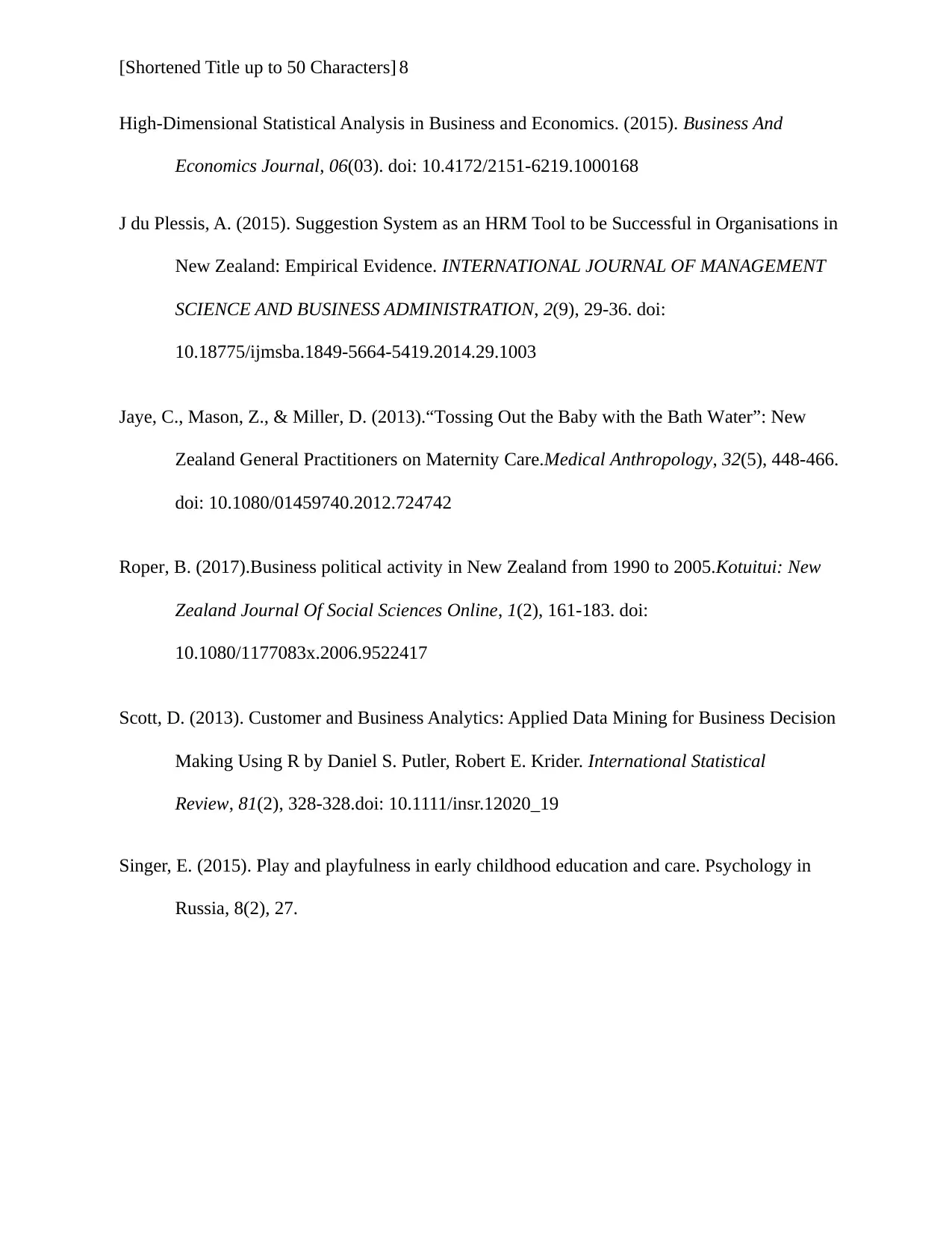
[Shortened Title up to 50 Characters] 8
High-Dimensional Statistical Analysis in Business and Economics. (2015). Business And
Economics Journal, 06(03). doi: 10.4172/2151-6219.1000168
J du Plessis, A. (2015). Suggestion System as an HRM Tool to be Successful in Organisations in
New Zealand: Empirical Evidence. INTERNATIONAL JOURNAL OF MANAGEMENT
SCIENCE AND BUSINESS ADMINISTRATION, 2(9), 29-36. doi:
10.18775/ijmsba.1849-5664-5419.2014.29.1003
Jaye, C., Mason, Z., & Miller, D. (2013).“Tossing Out the Baby with the Bath Water”: New
Zealand General Practitioners on Maternity Care.Medical Anthropology, 32(5), 448-466.
doi: 10.1080/01459740.2012.724742
Roper, B. (2017).Business political activity in New Zealand from 1990 to 2005.Kotuitui: New
Zealand Journal Of Social Sciences Online, 1(2), 161-183. doi:
10.1080/1177083x.2006.9522417
Scott, D. (2013). Customer and Business Analytics: Applied Data Mining for Business Decision
Making Using R by Daniel S. Putler, Robert E. Krider. International Statistical
Review, 81(2), 328-328.doi: 10.1111/insr.12020_19
Singer, E. (2015). Play and playfulness in early childhood education and care. Psychology in
Russia, 8(2), 27.
High-Dimensional Statistical Analysis in Business and Economics. (2015). Business And
Economics Journal, 06(03). doi: 10.4172/2151-6219.1000168
J du Plessis, A. (2015). Suggestion System as an HRM Tool to be Successful in Organisations in
New Zealand: Empirical Evidence. INTERNATIONAL JOURNAL OF MANAGEMENT
SCIENCE AND BUSINESS ADMINISTRATION, 2(9), 29-36. doi:
10.18775/ijmsba.1849-5664-5419.2014.29.1003
Jaye, C., Mason, Z., & Miller, D. (2013).“Tossing Out the Baby with the Bath Water”: New
Zealand General Practitioners on Maternity Care.Medical Anthropology, 32(5), 448-466.
doi: 10.1080/01459740.2012.724742
Roper, B. (2017).Business political activity in New Zealand from 1990 to 2005.Kotuitui: New
Zealand Journal Of Social Sciences Online, 1(2), 161-183. doi:
10.1080/1177083x.2006.9522417
Scott, D. (2013). Customer and Business Analytics: Applied Data Mining for Business Decision
Making Using R by Daniel S. Putler, Robert E. Krider. International Statistical
Review, 81(2), 328-328.doi: 10.1111/insr.12020_19
Singer, E. (2015). Play and playfulness in early childhood education and care. Psychology in
Russia, 8(2), 27.
1 out of 8
Your All-in-One AI-Powered Toolkit for Academic Success.
+13062052269
info@desklib.com
Available 24*7 on WhatsApp / Email
![[object Object]](/_next/static/media/star-bottom.7253800d.svg)
Unlock your academic potential
Copyright © 2020–2025 A2Z Services. All Rights Reserved. Developed and managed by ZUCOL.


